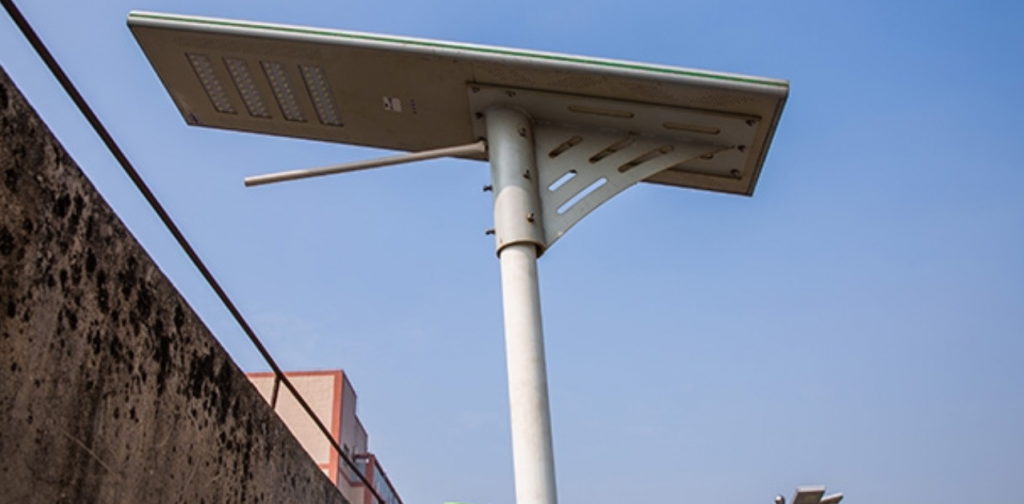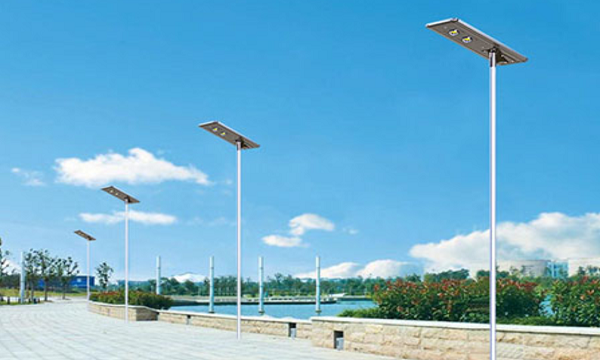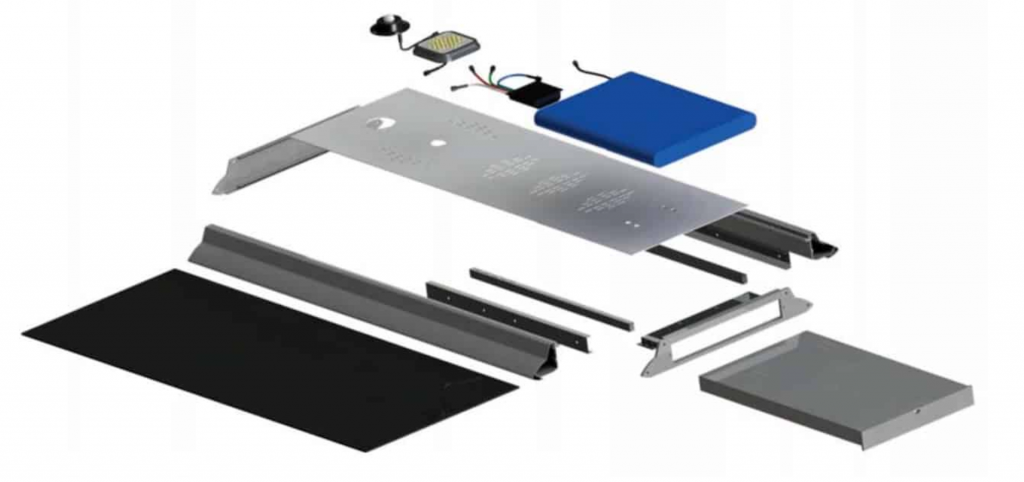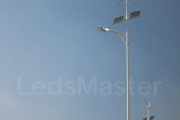Solar energy is the most direct, most common and cleanest energy source on earth. Solar energy is a huge amount of renewable energy. The radiant energy reaching the surface of the earth every day is approximately equal to 250 million barrels of oil. It can be said to be inexhaustible and inexhaustible.
Almost all the spectrum of the LED is concentrated in the visible light band, so the luminous efficiency is high. Most people believe that energy-saving lamps can save energy by 4/5 is a great innovation, but LED is more energy-efficient than energy-saving lamps by 1/3, which is a greater reform of solid-state light sources.
Solar LED lighting integrates the advantages of solar energy and LED.
System Introduction
Introduction to the Basic Components of the System
The system is composed of solar cell components (including brackets), LED lights, control box (with controller and battery inside) and light poles. The luminous efficiency of the solar panel reaches 127Wp/m2, and the efficiency is high, which is very beneficial to the wind-resistant design of the system. In the lamp part, 1W white light LED and 1W warm white light LED are integrated on the printed circuit board and arranged as a dot matrix with a certain interval as the plane light source.
The control box body is made of stainless steel, which is beautiful and durable. A maintenance-free lead-acid battery and a charge-discharge controller are placed in the control box. The system uses valve-regulated sealed lead-acid batteries, which are also called “maintenance-free batteries” because they are rarely maintained. Conducive to the reduction of system maintenance costs. The charge and discharge controller is designed with full functions (with light control, time control, overcharge protection, over discharge protection and reverse connection protection, etc.) and cost control to achieve a high cost performance.
Working Principle Introduction
The working principle of the system is simple. The solar cell made by using the principle of photovoltaic effect, during the day the solar panel receives solar radiation energy and converts it into electrical energy output, which is stored in the storage battery through the charge and discharge controller. At night, when the illuminance gradually decreases to about 10 lux, and the open circuit voltage of the solar panel is about 4.5V, the charge and discharge controller will act after detecting this voltage value, and the battery will discharge the lamp. After the battery is discharged for 8.5 hours, the charge and discharge controller will act, and the battery discharge ends. The main function of the charge and discharge controller is to protect the battery.
System Design Ideas
Compared with general solar lighting, the design of solar street lights has the same basic principles, but there are more links that need to be considered. The following will take this solar LED high-power street light from Tachyon Co., Ltd. as an example, and analyze it in several aspects.
Solar Cell Module Selection
Design requirements: CA area, load input voltage 24V, power consumption 34.5W, working hours per day 8.5h, guaranteed continuous rainy days for 7 days.
⑴ The average annual radiation in the LA area in the past two decades is 107.7Kcal/cm2, and the peak sunshine hours are about 3.424h after simple calculation;
⑵ Load daily power consumption = = 12.2AH
⑶ Total charging current of solar modules required = 1.05×12.2×÷(3.424×0.85)=5.9A
Here, the design shortest number of days between two consecutive cloudy and rainy days is 20 days, 1.05 is the comprehensive loss coefficient of the solar cell module system, and 0.85 is the battery charging efficiency.
⑷ The minimum total power of solar modules = 17.2×5.9 = 102W
The selection of standard battery components with a peak output power of 110Wp and a single 55Wp should be able to ensure the normal operation of the street lamp system in most cases in a year.
Battery Selection
The calculation of battery design capacity is simpler than the peak wattage of solar modules.
According to the above calculation, the daily power consumption of the load is 12.2AH. When the battery is full, it can work continuously for 7 rainy days, plus the work of the first night, the battery capacity:
12.2×(7 1) = 97.6 (AH), two 12V100AH batteries can meet the requirements.
Solar Module Bracket
(1) Angle design
In order to allow the solar cell modules to receive as much solar radiation energy as possible in a year, we have to choose an optimal inclination angle for the solar cell modules.
Discussions on the optimal inclination angle of solar cell modules have appeared a lot in some academic journals in recent years. The area where the street lights are used this time is the LA area. According to the information in the relevant literature for this design, the inclination angle of the solar cell module bracket is selected to be 16o.
(2) Wind-resistant design
In the solar street light system, a structural issue that requires great attention is the design of wind resistance. The wind resistance design is mainly divided into two parts, one is the wind resistance design of the battery module bracket, and the other is the wind resistance design of the light pole. Let’s analyze the above two pieces separately.
●Wind-resistant design of solar cell module bracket
According to the technical parameter data of the battery module manufacturer, the upwind pressure that the solar battery module can withstand is 2700Pa. If the wind resistance coefficient is selected as 27m/s (equivalent to a tenth typhoon), according to the non-viscous fluid mechanics, the wind pressure on the battery module is only 365Pa. Therefore, the component itself can withstand the wind speed of 27m/s without being damaged. Therefore, the key consideration in the design is the connection between the battery assembly bracket and the light pole.
In the design of the street lamp system, the connection design of the battery assembly bracket and the lamp pole uses a bolt pole to fix the connection.
●Wind-resistant design of street lamp pole
The parameters of street lights are as follows:
The inclination of the battery panel A = 16o, the height of the light pole = 5m
The design selects the welding seam width at the bottom of the light pole δ = 4mm, the outer diameter of the bottom of the light pole = 168mm
The surface where the weld is located is the destruction surface of the light pole. The distance from the calculation point P of the resistance moment W of the lamp pole failure surface to the line of action of the solar panel load F received by the lamp pole is PQ = [5000 (168 6)/tan16o] × Sin16o = 1545 mm = 1.545 m. Therefore, the moment of wind load on the failure surface of the light pole is M = F×1.545.
According to the design maximum allowable wind speed of 27m/s, the basic load of a 2×30W dual-cap solar street light battery panel is 730N. Considering the safety factor of 1.3, F = 1.3×730 = 949N.
Therefore, M = F×1.545 = 949×1.545 = 1466N.m.
According to mathematical derivation, the moment of resistance of the circular failure surface W = π×(3r2δ+3rδ2+δ3).
In the above formula, r is the inner diameter of the ring, and δ is the width of the ring.
Moment of resistance to failure surface W = π×(3r2δ+3rδ2+δ3)
=π×(3×842×4+3×84×42+43) = 88768 mm3
=88.768×10-6 m3
The stress caused by the moment of wind load on the failure surface = M/W
= 1466/(88.768×10-6) =16.5×106pa =16.5 Mpa<<215Mpa
Among them, 215 Mpa is the bending strength of Q235 steel.
Therefore, the width of the weld seam selected in the design meets the requirements, and as long as the welding quality can be guaranteed, the wind resistance of the light pole is no problem.
Controller
The main function of the solar charge and discharge controller is to protect the battery. The basic functions must have overcharge protection, overdischarge protection, light control, time control and anti-reverse connection, etc.
Battery overcharge and overdischarge protection voltage is a general parameter. When the battery voltage reaches the set value, it changes the state of the circuit.
In the selection of devices, there are currently single-chip microcomputers and comparators. There are many programs, each with its own characteristics and advantages. The corresponding program should be selected according to the needs and characteristics of the customer group, and I will not elaborate on them one by one here.
Surface treatment
This series of products uses new electrostatic coating technology, mainly FP professional building materials coatings, which can meet customers’ requirements for product surface color and environmental harmony. At the same time, the product has high self-cleaning property, strong corrosion resistance, and aging resistance, which is suitable for any climatic environment. The processing technology is designed to be coated on the basis of hot-dip galvanizing, which greatly improves the product performance and meets the most stringent requirements of AAMA2605.2005. Other indicators have reached or exceeded the relevant requirements of the International Electrical Association.
Concluding Remarks
The overall design basically takes into account all aspects. The peak wattage selection design and battery capacity selection design of photovoltaic modules adopt the most common design methods at present, and the design ideas are relatively scientific. The wind resistance design is analyzed from the two parts of the battery module bracket and the light pole, and the analysis is more comprehensive. The surface treatment adopts the most advanced technology at present. The overall structure of the street lamp is simple and beautiful. The actual operation proves that the matching between each link is better.
At present, the initial investment of solar LED lighting is still a major problem that plagues us. However, the light efficiency of solar cells is gradually improving, and the price will gradually decrease. Similarly, the luminous efficiency of LEDs on the market is rapidly increasing, while the price is decreasing.
Compared with the renewable, clean and pollution-free solar energy and the environmental protection and energy saving of LEDs, conventional fossil energy is becoming more and more tense, and after use, it will cause increasingly serious pollution to the environment. Therefore, as a kind of outdoor lighting in the ascendant, solar LED lighting will show us infinite vitality and broad prospects.









